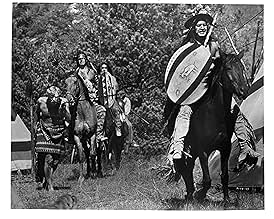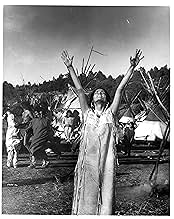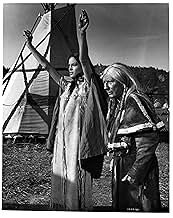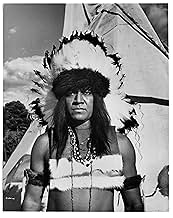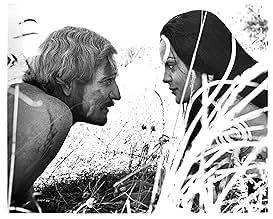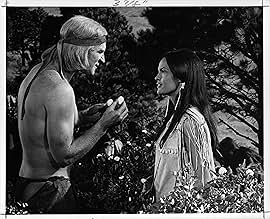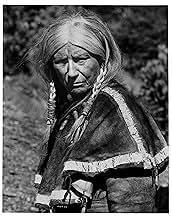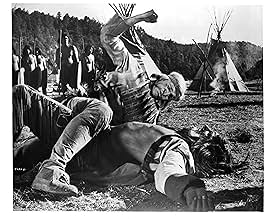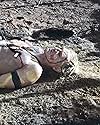CALIFICACIÓN DE IMDb
6.8/10
9.9 k
TU CALIFICACIÓN
En 1825, unos nativos americanos capturan a un aristócrata inglés. Convive con ellos y comienza a comprender su estilo de vida. Al final, lo aceptan como parte de la tribu y aspira a convert... Leer todoEn 1825, unos nativos americanos capturan a un aristócrata inglés. Convive con ellos y comienza a comprender su estilo de vida. Al final, lo aceptan como parte de la tribu y aspira a convertirse en su líder.En 1825, unos nativos americanos capturan a un aristócrata inglés. Convive con ellos y comienza a comprender su estilo de vida. Al final, lo aceptan como parte de la tribu y aspira a convertirse en su líder.
- Dirección
- Guionistas
- Elenco
- Premios
- 1 premio ganado y 2 nominaciones en total
Judith Anderson
- Buffalo Cow Head
- (as Dame Judith Anderson)
Lina Marín
- Thorn Rose
- (as Lina Marin)
- Dirección
- Guionistas
- Todo el elenco y el equipo
- Producción, taquilla y más en IMDbPro
Opiniones destacadas
In 1825, the Sioux, leaded by Yellow Hand (Manu Tupou), capture the English nobleman John Morgan (Richard Harris), while hunting in the United States of America. John is brutally treated like an animal by the Indian, and is given to help Buffalo Cow Head (Judith Anderson), the mother of Yellow Hand, as if he were a horse. Without understanding the language and behavior of the Sioux, he is helped by Batise (Jean Gascon), a white man made prisoner and mutilated by the Indians five years ago. Batise translates and explains the Sioux's culture for John, plotting to escape some day back to the civilization with him. After an undefined long time later, John loses his snobbish behavior and is reasonably integrated to the Sioux. One day, he kills two enemies Shoshones, who were spying and stalking the Sioux, and gains the respect of the Sioux and love of the sister of Yellow Hand, Running Deer (Corinna Tsopei). John marries Running Deer and integrates to their culture, and after a tragic attack of the Shoshones to the Sioux tribe, he becomes their leader. "A Man Called Horse" is a spectacular and powerful classic western of the 70's. The first time I saw this movie, I was a teenager and left the theater completely astonished with such a different story in that time and the violence of the scenes. Two days ago, I bought the VHS and yesterday I saw it again, and it is still a very impressive film, with magnificent performances of the cast, highlighting Richard Harris and Judith Anderson. The production is very careful, being mostly spoken in Sioux, and depicting in a realistic way, the life, the behavior, the common laws and the moral practices of the Sioux. I believe that "A Man Called Horse", with the Sioux, "Soldier Blue", with the Cheyenne and "Little Big Man", all of them from 1970, were among the first movies to show the lives of prisoners of the North American Indians in their tribes. The amazing scene of John Morgan suspended by his chest in an Indian ceremony is unforgettable and very impressive. My vote is ten.
Title (Brazil): "Um Homem Chamado Cavalo" ("Spectacular Classic Western")
Title (Brazil): "Um Homem Chamado Cavalo" ("Spectacular Classic Western")
"A Man Called Horse" is a very unusual film about the west for many reasons. It's NOT set during the usual 'glory days' when most films of the type were set (1866-1880). It had no cowboys. And, it had very little dialog in English.
The film begins with a rich Englishman, John Morgan (Richard Harris), on a hunting expedition in the American West in the 1830s. He and his party are attacked by Sioux warriors and Morgan is taken prisoner by the natives. At first, he's treated like a slave and his life truly sucks. It didn't help that the only one who spoke any English in the tribe was another slave who was French...and the guy was a little nuts! Through the course of the film, however, Morgan learns to respect and even enjoy life with the Sioux and becomes an important member of the tribe. There is naturally much more to it than that but it's best you just see it for yourself.
This movie is almost like an ethnographic portrait of the Sioux and the times instead of a typical western film. The usual sorts of clichés and expectations are mostly missing. Some will hate this--some will no doubt be relieved. All I know is that I enjoyed it and liked the more intimate and native-centered approach of the film. Well made all around...though the sun ceremony is NOT for the squeamish.
The film begins with a rich Englishman, John Morgan (Richard Harris), on a hunting expedition in the American West in the 1830s. He and his party are attacked by Sioux warriors and Morgan is taken prisoner by the natives. At first, he's treated like a slave and his life truly sucks. It didn't help that the only one who spoke any English in the tribe was another slave who was French...and the guy was a little nuts! Through the course of the film, however, Morgan learns to respect and even enjoy life with the Sioux and becomes an important member of the tribe. There is naturally much more to it than that but it's best you just see it for yourself.
This movie is almost like an ethnographic portrait of the Sioux and the times instead of a typical western film. The usual sorts of clichés and expectations are mostly missing. Some will hate this--some will no doubt be relieved. All I know is that I enjoyed it and liked the more intimate and native-centered approach of the film. Well made all around...though the sun ceremony is NOT for the squeamish.
at the beginning of this movie,there is a blurb about how the events portrayed are taken directly from historical documents of the period.the South Dakota Sioux Indians also had a lot of input into the movie.so,we can assume it is fairly accurate.one thing it does is show the Native American Indians as being just like any other people.this movie took awhile to get going,in my mind,but once it does,it's action packed,and it's very well acted.Richard Harris is the title character.he is a British Lord who is captured by the Sioux in the mid 1800's.first he is treated with disdain,as nothing more than a servant to the aging mother of the chief.gradually,though,things change,though,and he becomes much more.this is a very touching and heart breaking movie.it's also very thought provoking.overall,i give A Man Called Horse a 6/10
One of the first films to ever deal with the relationship between white men and Native Americans that wasn't slanted towards the white man, A MAN CALLED HORSE was released during the same year as the excellent Arthur Penn film LITTLE BIG MAN and the ultra-violent SOLDIER BLUE, which also dealt with the white man/Indian conflict. Richard Harris gives a great performance as an Englishman who loses his wagon team to, and is captured by, a group of Sioux Indians in the Dakota territory of the mid-1800s. He soon learns their ways of living, which primitive as they might be to us and to him are very traditional. Though the film is rated 'PG', be forewarned that there are scenes of violence and bloodshed (particularly the Sun Vow sequence) that could have gotten this film an 'R' (or a 'PG-13'), so the film is not exactly for kids. Nevertheless, it is worth seeing.
This movie offered a different perspective of the Sioux, and although controversial, it is worth a view. Director Elliot Silverstein doesn't glamorize the Indians and he doesn't make them victims of white injustice. He just tells it like it is, and I have to admire him for it. Many activists protested what they believed to be inaccuracies; nonetheless, the film is the other side of "Dances With Wolves" (really, it's more like "Run of the Arrow"). For an in-depth interview with Silverstein and the making of "A Man Called Horse," read "Making the White Man's Indian: Native Americns and Hollywood Movies." It's a great behind-the-scenes read of this and other popular Western pictures.
¿Sabías que…?
- TriviaThe story is based on the experience of Cabeza de Vaca, a Spanish soldier captured by indigenous Americans in 1528.
- ErroresThroughout the film the actress playing Running Deer can be seen with medium long, nicely manicured fingernails.
- Versiones alternativasOld German VHS version includes many alternate/more violent takes that are not on the US DVD (whereas the version on the DVD is the same as in the US), especially the ending is almost completely recut. On the other hand the US version includes a few lines which are not in the German version.
- ConexionesEdited into Commercial Entertainment Product (1992)
Selecciones populares
Inicia sesión para calificar y agrega a la lista de videos para obtener recomendaciones personalizadas
- How long is A Man Called Horse?Con tecnología de Alexa
- What is 'A Man Called Horse' about?
- Is 'A Man Called Horse' based on a book?
- Is it true that this movie is entirely in Sioux?
Detalles
- Fecha de lanzamiento
- Países de origen
- Idiomas
- También se conoce como
- A Man Called Horse
- Locaciones de filmación
- Productoras
- Ver más créditos de la compañía en IMDbPro
Taquilla
- Total en EE. UU. y Canadá
- USD 1,941,247
- Total a nivel mundial
- USD 44,000,000
- Tiempo de ejecución1 hora 54 minutos
- Mezcla de sonido
- Relación de aspecto
- 2.35 : 1
Contribuir a esta página
Sugiere una edición o agrega el contenido que falta

Principales brechas de datos
What is the Italian language plot outline for Un hombre llamado Caballo (1970)?
Responda

